|
|
|
| |
|
|
| |
Water Supply |
|
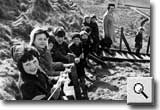 |
| |
Pupils
from Mrs Mabel Esson’s class at Perthudden,
a bay south of Collieston, in 1970. Mrs Esson was
a member
of staff at Slains School from 1967-1982 when there
were some seventy pupils on the school roll and
a
complement of three full-time teachers.
The steep, wooden, steps led down to Perthudden and
the Pumping Station, clearly visible behind the line
of children. Water, which provided the residents of
Collieston with their supply of mains water, was pumped
from an underground stream up to a header tank at
the top of Perthudden.
The wooden steps were subsequently dismantled and
removed in the 1990’s after the closure of the
Pumping Station. |
| |
|
|
| |
|
|
| |
| Aerial
View |
| |
An aerial
view, circa 1975, mainly featuring the part of Collieston
known as High Town. The photograph is dominated by
Slains
Lodge and its associated stable block. Formerly the
Whiteness Hotel and Shooting Lodge, Slains Lodge
also
served as military billets during the 1939-1945 World
War.
The stable block, a granite structure with slated
roofs, housed a small canning factory which produced
such diverse items as haggis and dog food. The factory
subsequently closed and was converted to housing in
the 1980’s and is now known as Forvie Court.
|
| |
|
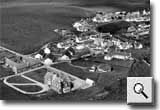 |
| |
|
|
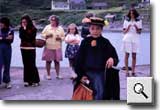 |
A young girl, Rosaleen Hay, in fancy dress, is standing
on the Pier during Collieston Gala Day in 1975.
|
|
| |
|
|
| |
| The
Sand Loch |
| |
The Sand
Loch is situated to the west of Collieston on the
Forvie National Nature Reserve. Forvie’s unique
moorland, dune system and beaches led to it being
declared as one of Scotland’s first National
Nature Reserves in January 1959
Collieston Hall, seen here in 1999, was originally
the Free Church and was built on the north shore of
the loch in 1862, with the church manse situated to
the rear. The property was sold in 1920 and was in
use as the Village Hall until 1960.
Subsequently bought by a local farmer who used it
as a grain store, the building was then sold in 1975
to a local builder. Both Church and Manse have been
modernised and are now private dwellings.
|
| |
|
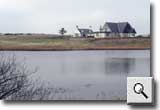 |
| |
|
|
| |
Slains
Parish Church |
|
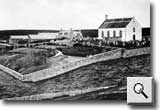 |
| |
Viewed
from the east circa 1910, the Kirkton farmhouse
is
clearly identifiable to the left of Slains Parish
Church. The present church building, dating from
1807 with
an original seating capacity of 650, is dedicated
to St Ternan who is reputed to have landed by boat
at Cransdale in the 5th Century. The walled manse
garden, clearly visible, is now an extension to
the
graveyard.
The entrance visible in the gable is no longer in
use and has been filled in. Among those buried in
the graveyard are several members of the Erroll family.
The Erroll Aisle is clearly visible at the side of
the church. |
|
|
| |
|
|
| |
| There
has not been a resident minister in Collieston since
the retirement of Rev John Murray in 1972 when the
manse was sold and Slains Parish was united with the
nearby Parish of Ellon. The farmhouse and steading
at Kirkton were converted to private housing in the
1990’s. |
| |
|
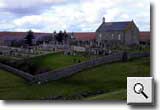 |
| |
|
|
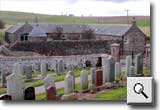 |
The
Glebe, viewed from the churchyard, in 1999. Built
in 1823 and reputedly the oldest building in Collieston,
the L-shaped building was originally the Manse Croft
and consisted of a winnowing barn, stable, byre, bothy
and coach-house.
The doocot (dovecot), clearly visible at the entrance
to the property and constructed in 1715, was home
to the doves or pigeons which provided the minister
and his family with food during the winter months.
The garden and glebe land of the Manse Croft would
have provided them with dairy produce, grain, fruit
and vegetables.
Subsequently the home of the church officer known
as the Beadle, the Glebe was sold by the Church of
Scotland in 1974 following the retirement of the Reverend
John Murray in 1972 and the uniting of the Parish
of Slains with the Parish of Ellon. Both Manse and
Glebe are now private dwellings.
|
| |
|
|
| |
|
|
| |
Education |
|
| |
| |
Pupils
are gathered in the playground of Slains School in
1970. At the time the school had a staff of three
full time teachers and some 60-70 pupils whose families
were resident in Slains, Auchmacoy and Collieston.
The majority of the pupils travelled to school by
bus. Those pupils who either walked or cycled were
in a minority.
Lunches were provided by the School Meals Service.
Cooked at nearby Cruden Bay School, the meals were
packed and transported to Slains on a daily basis
and eaten by both pupils and teachers in the dining
area of the hall.
The new school building visible behind the children
and opened on 21st September 1967 by Sir Douglas Ritchie,
was built to replace the old school building which
was eventually demolished in 1968.
|
| |
|
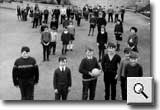 |
|
 |
|
| ....copyright
collieston's century 2003 |
|